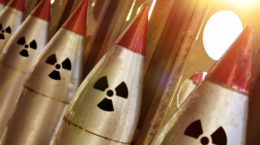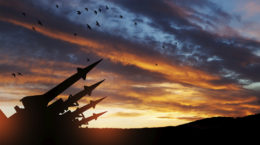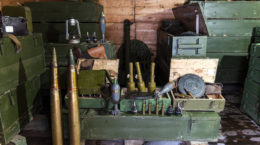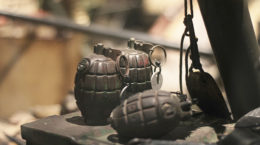Background of Nuclear Weapons
On July 22, 1993, Belarus signed the Treaty on the Non-Proliferation of Nuclear Weapons (NPT), resulting in the withdrawal of nuclear weapons from Belarus. After the collapse of the Soviet Union, Belarus was a country with the eighth largest nuclear-weapons stockpile in the world. The total number of warheads was 1,120. The grouping of strategic nuclear forces included about 180 formations, units and institutions numbering some 40,000 personnel.
Welcoming the fact that Belarus acceded to the Non-Proliferation Treaty as a non-nuclear weapon state, the UK, Russia and the US gave Belarus security guarantees, recording their commitments in the Budapest Memorandum of 5 December 1994. Nuclear weapons were withdrawn from Belarus in 1996.
These commitments have now been violated; since February 20, 2022, the Belarusian territory has been under the control of Russian troops, who illegally remain in Belarus without any explanation.
On May 15, 1992 Armenia, Kazakhstan, Kyrgyzstan, Russia, Tajikistan and Uzbekistan signed the Collective Security Treaty in Tashkent (Uzbekistan), but Belarus did not sign it until December 31, 1993.
On January 6, 1995, joint Russian and Belarusian agreement was signed to establish a Russian military facility – 43th the Russian naval communications centre Vileika (Antey Radio Station, RJH69) – a communications hub providing direct and return communications between the main headquarters of the Russian Navy and nuclear submarines on combat duty in areas of the Atlantic, Indian and partly Pacific Oceans. The agreement entered into force on May 31, 1996 for the Russian side and on June 7, 1996 for the Belarusian side, and remained in force for 25 years from that date. On July 2, 2021 Lukashenko announced that this military tower had been tried to blow up on the order of former German Chancellor Angela Merkel, and I was on the list of those terrorists.
On February 4, 2009, CSTO members reconciled and signed the project decree on creating CSTO Collective Rapid Reaction Force. According to the signed document, the CSTO Collective Rapid Reaction Force planned to be used for repeling military aggression, conducting special operations to combat international terrorism and extremism, transnational organised crime, drug trafficking, and to deal with the consequences of emergencies. Iran was invited as an observer.
On March 2, 2021, the Russian and Belarusian Defence ministries signed for the first time a five-year strategic military partnership programme.
On November 4, 2021, Lukashenko and Putin signed a new version of the military doctrine, which replaced the 2001 doctrine and the 1998 decision of the Supreme Council of the Union of Belarus and Russia “On the concept of a joint defense policy”. The document stresses that “Russian nuclear weapons will remain an important factor in preventing the outbreak of nuclear military conflicts and military conflicts with the use of conventional weapons. However, the new Military Doctrine of the Union State did not directly imply that Russian nuclear weapons could be deployed anywhere outside Russia.
On February 17, 2022, a week before Russia attacked Ukraine, Lukashenka said that Belarus did not need nuclear weapons in the absence of direct threats from “ill-wishes states”, but that the country was ready to deploy them on its territory with the emergence of such threats. He also threatened to deploy “supernuclear” weapons in Belarus. A year later, Lukashenka said that Belarus did not need strategic nuclear weapons (SNWs), but that tactical nuclear weapons could be useful. At the same time, he noted that Belarus was not going to strike the United States and European countries, which sounded alarming, given that Lukashenko always did exactly the opposite of what he said.
On February 27, 2022, three days after Russia began its aggression against Ukraine, Lukashenko held an anti-constitutional referendum to change the constitution along the lines of the 2014 referendum in Crimea and removed the reference in Article 18 to the non-nuclear status of Belarus.
On 25 March 2023, Vladimir Putin announced the transfer of tactical nuclear weapons to Belarus. Putin said that Lukashenka would not gain unauthorized control over the nuclear warheads.
Some interesting facts about Belarus:
- Every time the formal initiator of the growing militarization of Belarus is Alexander Lukashenko and never Putin. Including, formally, Lukashenko was the initiator of the introduction of a 30,000-strong force to Belarus for exercises in February 2022 and the sending of thousands of mobilized troops there for training in October 2022 under the pretext of creating a unified grouping of troops.
- Belarusians are a nation of pacifists; Belarusians are against weapons and war. According to a series of Chatham House polls for 2022, about 80% of the urban population of Belarus were against the deployment of nuclear weapons in the country. In 2022 alone, about 400 criminal cases were initiated in Belarus for refusing to join the army and take up arms. Today, since February 21, 2023, the death penalty is stipulated in Belarus for desertion and “high treason” of military personnel.
- Putin and Lukashenko try to observe some formality or an appearance of the law.
- Putin pretends that Lukashenko decides something and influences something in order to share responsibility with him.
- Lukashenko has publicly stated 13 times that he wants to have nuclear weapons in Belarus.
- Putin was already preparing an attack on Ukraine in 2020, when there were peaceful mass protests in Belarus. He only attacked Ukraine when he was already certain that the protest had been strangled and the Belarusian people had no strength left to rebel. If the protest was crushed in 2020, Putin would attack Ukraine in 2020. It turns out that Belarus has given Ukraine two more peaceful years by its protest in the conditions of unceasing terror.
Facts about the international arms trade that are important for understanding current situation:
- With the rise of Alexander Lukashenko to power in 1994, Belarus became one of the leaders of the world arms trade (selling off huge Soviet stockpiles, with a very large proportion of these weapons going to unstable countries, namely to various Islamic regimes and falling into the hands of terrorists).
- The money from arms sales never went into the state budget of Belarus, but was accumulated in a special presidential reserve fund, which was used to eliminate opponents, discredit, bribe and other black business to keep power.
- From 1999 to 2006 Lukashenko, using Belarus as a сover, was the 11th largest arms exporter in the world (according to US Congress data), with revenues of over $1 billion.
- Lukashenka has sold arms to terrorists such as Albanian fighters from the Kosovo Liberation Army, China, Sudan, Pakistan, Syria, Kurdistan and Yemen terrorists. Belarus was the second largest arms supplier to Bashar al-Assad in 2007-2011 with a market share of 17%. Lukashenka negotiated with Hugo Chávez for $720 million in arms sales through Viktor Sheiman, responsible for the assassinations of Lukashenka’s most popular opponents.
But these were all weapons from Soviet stocks.
- Belarusian arms sales quickly went into decline around 2012. As a result, according to SIPRI, in 2008-2012 Belarus was the world’s 20th largest arms exporter with a market share of 0.3%. By comparison, between 2013 and 2017, Lukashenko controlled 0.5% of the world’s arms exports.
- Lukashenka started investing in the development of military innovations in electronics. In 2012 alone, organizations within a system of the Belarusian State Military Industrial Committee completed the development and launched production of more than 35 samples of modern innovative products and gained access to the Russian military market.
- In 2014, after the annexation of Crimea, Russia decided that all components of Russian weapons must be manufactured only in Russia. This undermined Lukashenko’s military business.
What’s up today:
- Belarus’ share of global arms imports in 2018-2022 was 0.6%, an increase of 20% over the previous five-year period (SIPRI) due to the war.
- Belarus and Russia have compiled a list of critical electronic component base for the Russian defense industry, and Belarusian companies have already started the first deliveries. The Lukashenko regime has approved a programme to develop the microelectronics industry in Belarus until 2030. In other words, Lukashenko is betting on the production of electronics for the Russian Defense Ministry, which Russia cannot get from the West today because of sanctions.
- During the year of war 2022, Planar increased its exports by 70% and its revenues amounted to 57.5 million rubles, which is approximately 23 million dollars (21% higher than in 2021). Net profit reached 26.4 million rubles; net profit was $10 million (The planned profit was Br12.2 million).
- Russia’s strategic decision is to manufacture part of the components in Belarus.
We demand:
- Compliance with the Budapest Memorandum for Belarus too.
- The Belarus issue should also be on the post-war agenda and in the creation of a new security architecture for our region. We will never accept the current situation, namely the illegal presence of Russian troops on the territory of Belarus. Russian military bases should be withdrawn from Belarus as soon as possible, Russian troops should be withdrawn. The Belarusian people choose pacifism, a country without weapons, withdrawal from the CSTO and all military blocs with Russia.
- On Belarus, we should actively use the UN article 1325 on the involvement of women peacekeepers in conflict resolution. We need reliable information about what is and will be happening at the Russian military bases, as well as at the bases where nuclear weapons will be deployed. This can only be done by peaceful Belarusians who will monitor and transmit the necessary information. So, restoring the number of active citizens, and especially women in Belarus, is a priority issue today.
- We should investigate all of Lukashenko’s black and illegal arms sales schemes and block them. We want to impose economic sanctions on all Belarusian enterprises that now work for the military orders of the Russian Defense Ministry of Defense and help Putin in this war. We need to conduct campaign inside Belarus so that Putin fears bringing tactical nuclear weapons into Belarus.
- We want an international coalition of non-governmental initiatives and organizations as well as state institutions on the following issues: militarization of Belarus, training of child soldiers by the Belarusian Defense Ministry, illegal sale of weapons, production of Russian Defense Ministry products in Belarus and at Belarusian enterprises, deportation of Ukrainian children to Belarus, incessant terror in Belarus. We will fight against the deployment of nuclear weapons in Belarus.
- We urge everyone to launch and actively support campaigns to monitor arms sales by the Lukashenko regime, to strengthen voices within Belarus among the population on Russia’s violation of the nuclear non-proliferation treaty in Belarus, and to strengthen pacifist sentiment in Belarus and among the population as a guarantee that Lukashenko cannot send an army to Ukraine to support Putin. We ask for the support to Belarusian men who do not want to take up arms today.
Olga Karach
Our House










